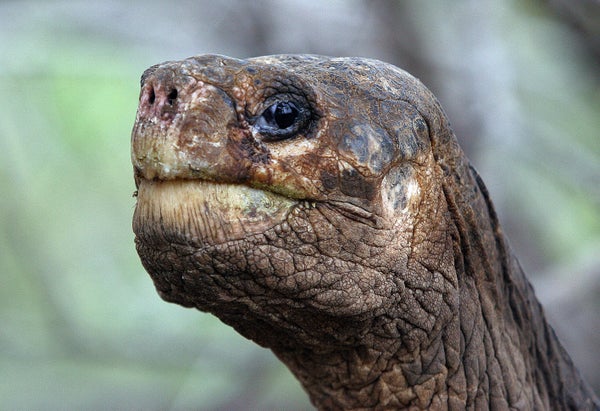This article was published in Scientific American’s former blog network and reflects the views of the author, not necessarily those of Scientific American
He was the last of his kind and now he is gone. Lonesome George, the world-famous Pinta Island tortoise (Chelonoidis nigra abingdoni) has died in the Galápagos Islands off the coast of Ecuador. George, estimated to be at least 100 years old, was the last known member of his subspecies, and his solitary existence for the past 40 years has made him a poster boy for conservation and endangered species.
Galápagos giant tortoises like Lonesome George played an important role in the development of Charles Darwin's theory of evolution. Darwin famously observed the differences between tortoise subspecies when he visited the Galápagos in 1835 and later wrote about them in On the Origin of Species.
George (or Jorge as he was known in Spanish) was found dead on Sunday, June 24 in his corral on Santa Cruz Island by his keeper, Fausto Llerena, who had looked after the tortoise for the past 40 years. A necropsy performed on Monday indicated he may have died of a heart attack. Officials from the Galápagos National Park Service (GNPS) said his body will be preserved for future study.
On supporting science journalism
If you're enjoying this article, consider supporting our award-winning journalism by subscribing. By purchasing a subscription you are helping to ensure the future of impactful stories about the discoveries and ideas shaping our world today.
Pinta Island tortoises were overhunted in the 19th century by protein-hungry fishermen and sailors, and they suffered further during that century as the island was overrun by invasive feral goats, which destroyed the tortoises' habitat. Before George the subspecies was last seen in 1906, when three males were collected from the island by the California Academy of Sciences. But in December 1971 biologist Joseph Vagvolgyi photographed a tortoise that by all accounts should not have existed. Found again and captured in 1972, Jorge soon became a media celebrity and a symbol for hope that others of his kind might still be out there. That hope never panned out, despite a $10,000 reward and years of searching the island.
No one ever knew George's exact age. He was probably full-grown in 1972, a stage other giant tortoise species reach after about 20 to 30 years. He was also in good health, so he was probably not much older than 50 or 60 at the time. Giant tortoises can live upward of 200 years, so by all guesses he hadn't quite reached middle age at the time of his death. He suffered a few health hiccups through the years, including a near-fatal fall in 1980 and periods of constipation and obesity. Strict diets and veterinary care had otherwise kept him in good shape.
In hopes of preserving at least some of his genetic material, George was paired with several females of related subspecies over the years. For most of that time though, he showed no interest in breeding. Even attempts to extract his sperm came to naught. George did finally mate a couple of times but the resulting eggs—laid in 2008 and 2009—were infertile and did not hatch.
George may have been dubbed Lonesome, but actually he was never alone. Millions of visitors have come to the Darwin research station over the years to get a glimpse of the world's most famous living reptile, not to mention its most famous endangered creature. In his 2006 book, Lonesome George: The Life and Loves of a Conservation Icon (Palgrave Macmillan), journalist Henry Nicholls wrote that Jorge was "a symbol of the devastation man has wrought to the natural world in the Galápagos and beyond."
Approximately 20,000 Galápagos giant tortoises remain on the islands that Darwin made famous, representing nine to 15 subspecies (the exact number is still being determined). At least one other subspecies, the Duncan Island tortoise (C. n. duncanensis), is classified on the IUCN Red List of Threatened Species as "Extinct in the Wild" and only exists in captivity. Another, the Hood Island tortoise (C. n. hoodensis), is "Critically Endangered."
The GNPS will hold a workshop on conserving the remaining Galápagos tortoise subspecies in July. The event will be dedicated to the memory of Lonesome George.
